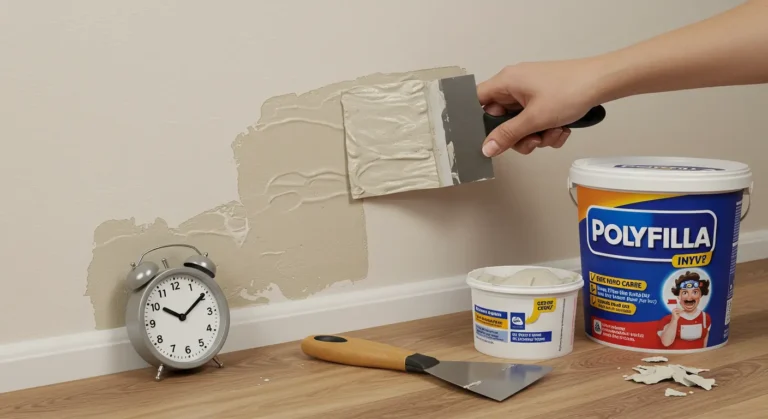Introduction:
If you’ve ever asked yourself “how long does Polyfilla take to dry?”, you’re in the right place. Polyfilla is a popular wall filler used to repair cracks, holes, and other imperfections in walls and ceilings. The drying time for Polyfilla can vary, depending on several factors such as the type of Polyfilla used, the thickness of the application, and environmental conditions. In this guide, we will explain the Polyfilla drying time in detail and share tips for speeding up the drying process.
Understanding how long Polyfilla takes to dry will help you plan your home improvement projects more effectively and avoid any delays. Whether you’re using fast-drying filler or a standard formula, knowing the drying time is key to getting the best results.
What is Polyfilla?
Polyfilla is a versatile filler used for filling small holes, cracks, and damaged areas in walls. It’s commonly used for interior surfaces such as drywall, plaster, and wood. Polyfilla is available in different formulations, including quick-drying Polyfilla and powdered wall fillers that require mixing with water. The product provides a smooth finish and is easy to apply, making it ideal for DIY repairs. The drying time for Polyfilla depends on the type and thickness of the application, as well as environmental factors like temperature and humidity.
How Long Does Polyfilla Take to Dry?
The drying process for Polyfilla can vary depending on several factors. In general, Polyfilla takes about 1 to 4 hours to dry for a single layer, but there are variables to consider.
Factors Affecting Polyfilla Drying Time:
- Type of Polyfilla:
Quick-drying Polyfilla typically dries faster than regular powdered wall fillers. Ready-mixed Polyfilla formulas might take longer to dry due to their higher moisture content, while powdered fillers dry faster once mixed. If you’re using a fast-drying wall filler, the drying time could be reduced significantly. - Thickness of Application:
Thicker applications of Polyfilla will naturally take longer to dry. For smaller cracks or minor imperfections, a thin layer of filler will dry faster. However, if you’re filling deep holes or cracks, you’ll need to apply Polyfilla in layers, allowing each layer to dry before applying the next. This approach will help prevent extended drying times caused by thick applications. - Environmental Conditions:
Humidity and temperature play a significant role in Polyfilla curing time. In high humidity or colder temperatures, Polyfilla will take longer to dry. On the other hand, drying time for Polyfilla is faster in a well-ventilated, warm space. Ideally, the room temperature should be between 15°C and 25°C for the best drying results. Using a heater or dehumidifier can help speed up the process, especially in damp environments. - Air Circulation:
Proper airflow can significantly improve Polyfilla drying time. If you’re working in a room with little air circulation, consider using a fan to help the moisture evaporate more quickly. The more air circulation you have, the quicker the filler drying time will be.
Tips to Speed Up Polyfilla Drying Time
If you’re in a rush and need Polyfilla to dry faster, here are some tips:
- Increase Airflow:
Open windows or use a fan to increase airflow in the room. This will help Polyfilla dry faster by encouraging moisture to evaporate more quickly. - Use a Heater:
If the room is cold, use a space heater to increase the temperature. Higher temperatures will speed up the drying process for Polyfilla, but be sure not to overheat the room as excessive heat can cause the filler to crack. - Apply Thin Layers:
Instead of applying a thick layer of Polyfilla to fill deep holes, try applying multiple thin layers. Each layer will dry faster, and you can avoid prolonged drying times caused by thick applications. - Use a Fast-Drying Formula:
If you’re working on a project that requires a quick turnaround, use fast-drying wall filler. These types of products are designed to reduce Polyfilla curing time, helping you get the job done quicker.
Common Questions About Polyfilla Drying
Q1: Can I paint over Polyfilla before it is completely dry?
It’s best to wait until Polyfilla is fully dry before painting over it. Applying paint on partially dry Polyfilla could trap moisture, causing the paint to peel or crack later. Typically, Polyfilla takes about 2 to 4 hours to dry, but it’s recommended to check the manufacturer’s instructions for more precise timing.
Q2: How long does Polyfilla take to dry overnight?
For larger holes or deep cracks, it may take longer than a few hours to completely dry. Polyfilla applied overnight will be fully dry by morning, especially if you used fast-drying filler. However, make sure to let it dry for 24 hours for thicker applications to ensure it’s completely cured.
Q3: Does humidity affect Polyfilla drying?
Yes, humidity can slow down the drying process for Polyfilla. In high-humidity environments, it may take longer for the Polyfilla curing time to complete. To mitigate this, increase airflow or use a dehumidifier to accelerate the drying time.
Read More : How Much Does a Fridge Weigh? Discover the Surprising Truth Behind Fridge Weight
Conclusion
So, how long does Polyfilla take to dry? On average, Polyfilla takes around 1 to 4 hours to dry, depending on the type, application thickness, and environmental conditions. For larger or deeper repairs, you may need to wait a bit longer. Applying thin layers of Polyfilla and using a fast-drying wall filler can speed up the process. Make sure to allow for proper air circulation and keep the temperature in the ideal range to ensure the best results.
Whether you’re fixing small holes or larger cracks, knowing the drying time for Polyfilla and the best practices for speeding it up will help you get your DIY repairs done efficiently. Happy repairing!

